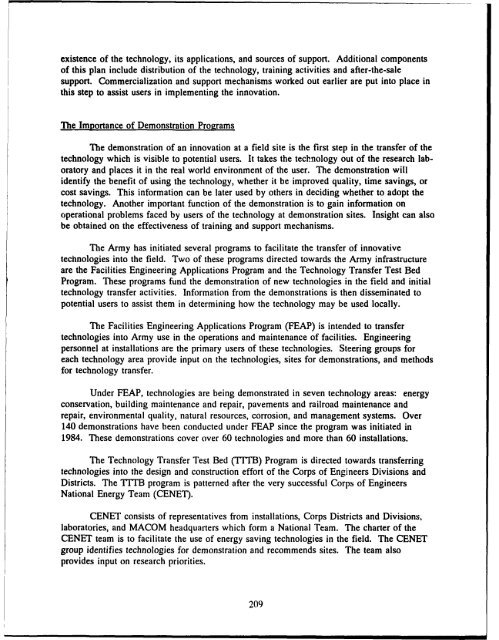Challenges and Opportunities for Innovation in the Public Works ...
Challenges and Opportunities for Innovation in the Public Works ...
Challenges and Opportunities for Innovation in the Public Works ...
Create successful ePaper yourself
Turn your PDF publications into a flip-book with our unique Google optimized e-Paper software.
existence of <strong>the</strong> technology, its applications, <strong>and</strong> sources of support. Additional components<br />
of this plan <strong>in</strong>clude distribution of <strong>the</strong> technology, tra<strong>in</strong><strong>in</strong>g activities <strong>and</strong> after-<strong>the</strong>-sale<br />
support. Commercialization <strong>and</strong> support mechanisms worked out earlier are put <strong>in</strong>to place <strong>in</strong><br />
this step to assist users <strong>in</strong> implement<strong>in</strong>g <strong>the</strong> <strong>in</strong>novation.<br />
The Imnortance of Demonstration Programs<br />
The demonstration of an <strong>in</strong>novation at a field site is <strong>the</strong> first step <strong>in</strong> <strong>the</strong> transfer of <strong>the</strong><br />
technology which is visible to potential users. It takes <strong>the</strong> technology out of <strong>the</strong> research laboratory<br />
<strong>and</strong> places it <strong>in</strong> <strong>the</strong> real world environment of <strong>the</strong> user. The demonstration will<br />
identify <strong>the</strong> benefit of us<strong>in</strong>g <strong>the</strong> technology, whe<strong>the</strong>r it be improved quality, time sav<strong>in</strong>gs, or<br />
cost sav<strong>in</strong>gs. This <strong>in</strong><strong>for</strong>mation can be later used by o<strong>the</strong>rs <strong>in</strong> decid<strong>in</strong>g whe<strong>the</strong>r to adopt <strong>the</strong><br />
technology. Ano<strong>the</strong>r important function of <strong>the</strong> demonstration is to ga<strong>in</strong> <strong>in</strong><strong>for</strong>mation on<br />
operational problems faced by users of <strong>the</strong> technology at demonstration sites. Insight can also<br />
be obta<strong>in</strong>ed on <strong>the</strong> effectiveness of tra<strong>in</strong><strong>in</strong>g <strong>and</strong> support mechanisms.<br />
The Army has <strong>in</strong>itiated several programs to facilitate <strong>the</strong> transfer of <strong>in</strong>novative<br />
technologies <strong>in</strong>to <strong>the</strong> field. Two of <strong>the</strong>se programs directed towards <strong>the</strong> Army <strong>in</strong>frastructure<br />
are <strong>the</strong> Facilities Eng<strong>in</strong>eer<strong>in</strong>g Applications Program <strong>and</strong> <strong>the</strong> Technology Transfer Test Bed<br />
Program. These programs fund <strong>the</strong> demonstration of new technologies <strong>in</strong> <strong>the</strong> field <strong>and</strong> <strong>in</strong>itial<br />
technology transfer activities. In<strong>for</strong>mation from <strong>the</strong> demonstrations is <strong>the</strong>n dissem<strong>in</strong>ated to<br />
potential users to assist <strong>the</strong>m <strong>in</strong> determ<strong>in</strong><strong>in</strong>g how <strong>the</strong> technology may be used locally.<br />
The Facilities Eng<strong>in</strong>eer<strong>in</strong>g Applications Program (FEAP) is <strong>in</strong>tended to transfer<br />
technologies <strong>in</strong>to Army use <strong>in</strong> <strong>the</strong> operations <strong>and</strong> ma<strong>in</strong>tenance of facilities. Eng<strong>in</strong>eer<strong>in</strong>g<br />
personnel at <strong>in</strong>stallations are <strong>the</strong> primary users of <strong>the</strong>se technologies. Steer<strong>in</strong>g groups <strong>for</strong><br />
each technology area provide <strong>in</strong>put on <strong>the</strong> technologies, sites <strong>for</strong> demonstrations, <strong>and</strong> methods<br />
<strong>for</strong> technology transfer.<br />
Under FEAP, technologies are be<strong>in</strong>g demonstrated <strong>in</strong> seven technology areas: energy<br />
conservation, build<strong>in</strong>g ma<strong>in</strong>tenance <strong>and</strong> repair, pavements <strong>and</strong> railroad ma<strong>in</strong>tenance <strong>and</strong><br />
repair, environmental quality, natural resources, corrosion, <strong>and</strong> management systems. Over<br />
140 demonstrations have been conducted under FEAP s<strong>in</strong>ce <strong>the</strong> program was <strong>in</strong>itiated <strong>in</strong><br />
1984. These demonstrations cover over 60 technologies <strong>and</strong> more than 60 <strong>in</strong>stallations.<br />
The Technology Transfer Test Bed (TITB) Program is directed towards transferr<strong>in</strong>g<br />
technologies <strong>in</strong>to <strong>the</strong> design <strong>and</strong> construction ef<strong>for</strong>t of <strong>the</strong> Corps of Eng<strong>in</strong>eers Divisions <strong>and</strong><br />
Districts. The TMTB program is patterned after <strong>the</strong> very successful Corps of Eng<strong>in</strong>eers<br />
National Energy Team (CENET).<br />
CENET consists of representatives from <strong>in</strong>stallations, Corps Districts <strong>and</strong> Divisions,<br />
laboratories, <strong>and</strong> MACOM headquarters which <strong>for</strong>m a National Team. The charter of <strong>the</strong><br />
CENET team is to facilitate <strong>the</strong> use of energy sav<strong>in</strong>g technologies <strong>in</strong> <strong>the</strong> field. The CENET<br />
group identifies technologies <strong>for</strong> demonstration <strong>and</strong> recommends sites. The team also<br />
provides <strong>in</strong>put on research priorities.<br />
209







